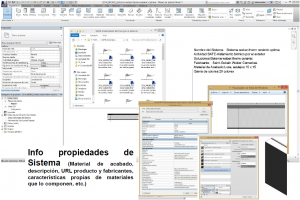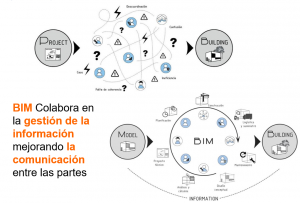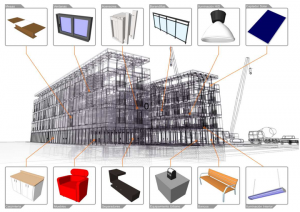BIM and the construction product sales process.
BIM and the construction product sales process.
The Commercial Department of the Manufacturing company will sell more if its strategy is to offer its clients (Architecture, engineering, construction companies) technical specification services based on BIM.
We know that selling products in the construction industry is difficult, either because of the existing aggressive competition or because of a price war that the salesperson often has to contend with in order to make a sale.
The change of technologies requires a change of mentality in the sales strategy

However, the rules of the game change when the manufacturer can help his client solve a problem, either at the design stage or during the execution of the project. In this case, the manufacturer is involved in the result, providing their knowledge about the product and technical experience in its applications, generating a relationship of trust that seeks to retain the customer. In short, its the Technical Specification Department that helps improve the sales ratio for the Sales Department. This fact or strategy is not new; there are many companies that offer their technical department services. But are these technical departments adapted to BIM?
BIM is for many the future, but for other companies it is the present. There are manufacturers and professionals who have already made the jump to BIM through an economic investment (purchase of software, hardware, qualified personnel, training courses, etc.) and knowledge (through implementation and experience). The truth is that BIM companies and professionals are more efficient and competitive in the provision of their services and this radically changes the rules of the game as construction is not done in the same manner anymore and this directly influences the sales process.

A branded BIM object is a work tool for the professional and for the company that provides this file. It is an opportunity for the brand to be present in the project. It is increasingly common to see in public or private bids that the projects are required to be presented in BIM, generating a technical demand in the market. If we add that the manufacturer that has its BIM library collaborates in the design process contributing its technical experience in BIM, the circle closes; since not only does the manufacturer know that the professional has received the files, but it knows that they are speficied in the project because they have participated directly in the design phase. For all this, having a BIM technical department is to take advantage of business opportunities.
Is the manufacturer prepared to offer these services?
The truth is that there are already several companies in Spain (+ 350 manufacturing companies) and in the world that have developed a BIM library, to a greater or lesser extent, but very few that offer technical assistance services in BIM in projects . This makes us think “What are they waiting for?”

It has been that most manufacturers have only made a first initial investment that helps them say they are already in BIM, but the truth is that they are not taking advantage of all the potential offered by this methodology. I say “methodology” because exactly what BIM offers is the opportunity for the manufacturer to participate in the process, providing information and knowledge to the project. The Manufacturer is more a collaborative Agent in BIM processes.

Also, to be able to participate and have the possibility to be chosen as a Partner, it is necessary to have the right team that can provide effective assistance (to do BIM and not simple 3D modeling). That is, to have a staff that has the skills and experience necessary to meet the needs of the client. This is to warn that not all CVs that we receive who claim to be BIM Manager or experts in BIM are of use (since there is a lot mis-representation in some CVs), and this is detected by presenting a knowledge test. In the interview itself present Real case scenario, the software and the means to solve it. if the applicant succeeds, he may be part of your staff, if not, it is better not to gamble with your company’s image.
Cost of Opportunity Vs Investment to generate a BIM technical department
Incorporating a BIM Technical Department in an initial or early stage in the manufacturing company can be costly or unprofitable if the “effective demand for its services” is not known. In other words, the risk of the investment can be high, if the volume of real need for the service is not detected.

We know that more projects are being constructed using BIM and that it is a new venue to be present in and sell, but how to do it and what strategy is implemented can make the difference between achieving success or creating a disappointment.
You have to reduce the risk. For this there are two strategies that if applied together will give good commercial results: 1st is contracting a quality outsourcing service and 2nd is a strategy of promotion and recruitment of professionals
Hiring a quality Outsourcing service
 As discussed in previous entries, investing in an early or initial phase in generating a BIM technical department can be costly and risky. A good formula is to hire external experts to help in that first phase since to know if the critical mass of technical assistance requests is sufficient to justify an investment in having our own department, or not.
As discussed in previous entries, investing in an early or initial phase in generating a BIM technical department can be costly and risky. A good formula is to hire external experts to help in that first phase since to know if the critical mass of technical assistance requests is sufficient to justify an investment in having our own department, or not.
Important point, if you hire external services make sure they are qualified experts and offer guarantees in the service since they will speak in the name of your brand.
Promotion strategy and recruitment of professionals
Having an internal or external department of technical services in BIM is the first step, but it is not enough. If you can not promote and properly engage users who need your services you will be increasing the cost of the investment because it will ultimately be based on the results achieved.
 Therefore, an adequate communication strategy must be drawn up, analyzing who can provide communication services focused on BIM and databases of BIM professionals. Not all agencies and media are specialized in BIM, even if they are dedicated to the construction industry and have a base of construction professionals. Remember that “a BIM professional is an Construction industry professional, but not all Construction industry professionals are BIM professionals. ”
Therefore, an adequate communication strategy must be drawn up, analyzing who can provide communication services focused on BIM and databases of BIM professionals. Not all agencies and media are specialized in BIM, even if they are dedicated to the construction industry and have a base of construction professionals. Remember that “a BIM professional is an Construction industry professional, but not all Construction industry professionals are BIM professionals. ”
Finally, filter the requests for assistance in projects, since depending on the needs and projects the technical department can provide the added value needed for the sales team to make a sale.
- Author ©2018 – Pablo Daniel Callegaris Rodríguez
- CEO – BIMETICA
- CEO – BIMLegal
- CEO – BIMCopyright













